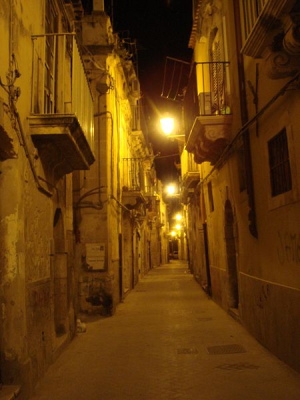
A street in Ortigia at night.
The Island of Ortigia (Siracusa, Italy)
The simultaneous presence of a fresh water
source and of a recess of the coast, suitable to protect the anchorage
of ships, attracted in 734-33 B.C. the Greek
colonists of Corinth
to the island (at that time still a peninsula) of Ortigia in Sicily.
Here the Greeks founded the city of Syracuse,
chasing out the Sicels
who had already populated for centuries the area before them.
The choice proved to be fortunate, to the point that the newly founded city not long after started to expand even onto the mainland, arriving in time to articulate a set of five principal areas, called "Pentapolis", with an overall population (on the order of hundreds of thousands of people) that formed, before the Roman conquest and decadence, one of the largest metropolises of the ancient Mediterranean.
Ortigia is one of a few centers of the Mediterranean to conserve the Ancient Greek urban framework in such a way as to still be legible on a map. The structure of the streets, despite more than two millennia of evolution, still respects the "comb teeth" orientation that radiates from a principal street, the Sacred Way (the present Via Dione), which runs through the center of the island.
Over the centuries the urban structure was centered around "ronchi" (alleys) and courtyards, where people lived outdoors throughout most of the day, while the house was designed as a place to store work tools and as a shelter at nighttime.
The island of Ortigia is slightly larger
than a square kilometer / 0.39 square miles,
but concentrated within it is an extraordinary density of monuments
of historic and artistic importance.
A less-than-superficial visit of Syracuse
requires at least three days, one of which must be dedicated solely to
Ortigia, while another can be reserved for the archeological treasures
of the mainland.
Some of this time can be dedicated to simply strolling through the streets lined with baroque buildings that compete for attention by exhibiting extraordinary balconies, one different from the next and one more whimsical and bizarre than the others.
The recommended route is the one heading to the right down the street on which the Algilà Ortigia Charme Hotel is situated, the Via Vittorio Veneto, lined with Baroque buildings, mostly restored, and even some surviving gothic and renaissance buildings.
After a bit, the street crosses the “Strada Nobile” (“Noble Street”) of Syracuse, lined with even bigger and more grand baroque buildings.
Heading to the right one reaches Piazza Archimede, and along a street that passes in front of Santa Maria della Concezione, one arrives at last at the extraordinary Piazza del Duomo, from which it is possible to proceed from the city center in any direction. A recommended detour is the ancient Jewish quarter, the Giudecca.
During this walk one is advised to enter the courtyards, within several of which the stairs are true theatrical wings that cannot be appreciated from the exterior. Among the many, we recommend the courtyard of the Palazzo Gargallo, very close to the Algilà Ortigia Charme Hotel – which provides a scenic taste of the baroque over preexisting gothic elements, or that of Palazzo Bonanno, in Via Maestranza 55, with a grandiose open gallery. A visit to this building is worth the effort.
Instead of through the heart of the island, a different itinerary is possible along its edges, indulging in a relaxing stroll along the seaside, which is filled with interesting tourist attractions and ancient historic monuments.
And don’t forget to take time to sit at a table at a bar to taste a fresh “latte di mandorle” (“almond milk”), or if it’s the season, a Sicilian granita, or if only to be tempted by the gastronomy of Sicilian pastry, sold in the many artisanal shops found in Ortigia.
Back to TOURISM IN SYRACUSE, SICILY